Downsize Your Closet
Find out how to downsize your closet effortlessly and seamlessly
Find out how to downsize your closet effortlessly and seamlessly
Why bigger is not always better
What is sustainability? How does it affect me? What does it have to do with tiny living?
What is Minimalism & what does it mean for you?
The tiny house amendment has gone through all the previous stages of approval: registered voters in Great Barrington will vote on whether to allow them at the annual town meeting on May 6.
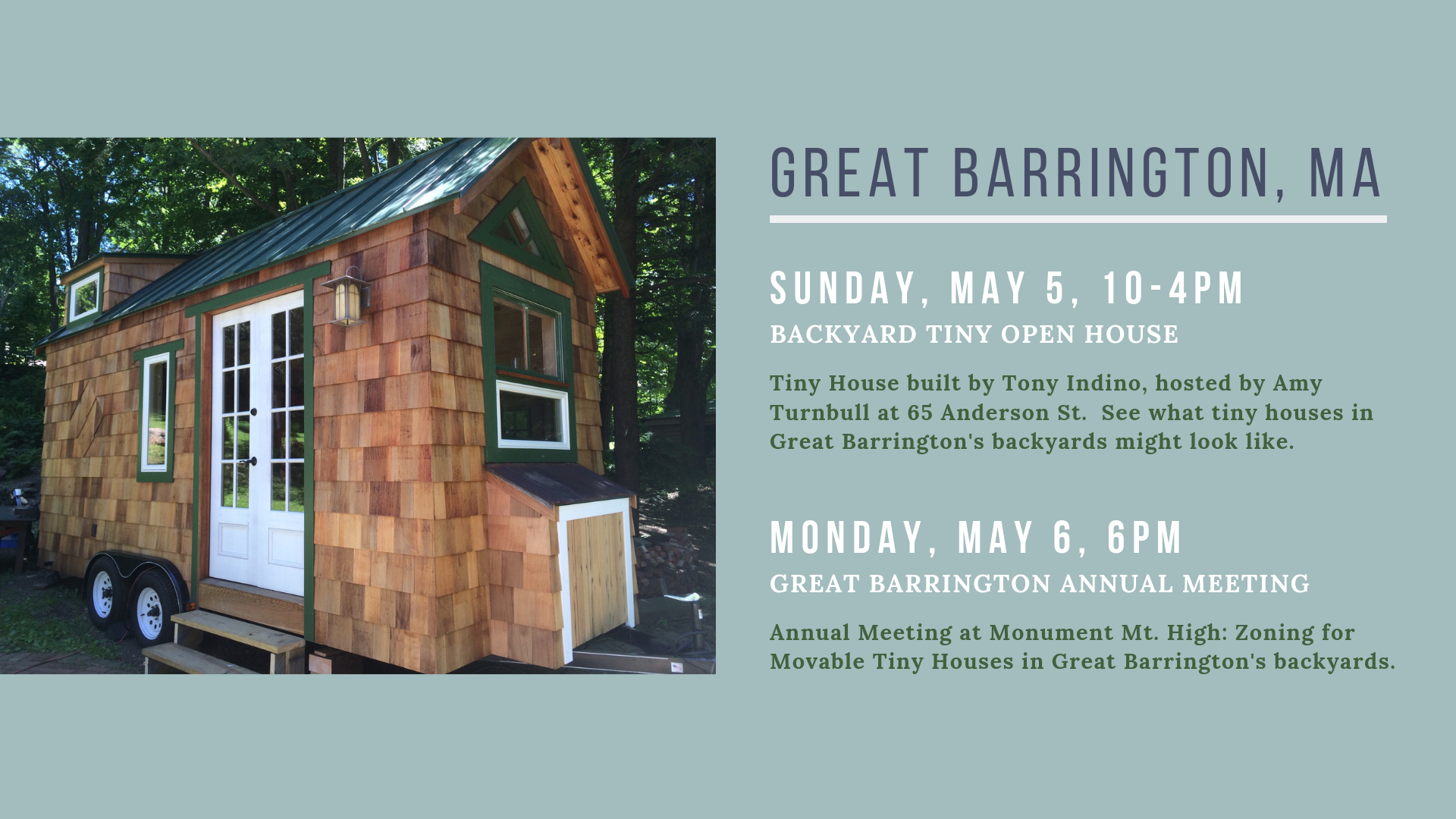
Katie Jackson of B&B Tiny Houses was asked to do a presentation at a planning board meeting on what tiny houses are, how they work, and how other cities have written them into their zoning code. Katie is also the Northeast Regional Director of the American Tiny House Association, which is hosting the open house on May 5.
Here’s our previous update on Great Barrington’s consideration of allowing tiny houses on wheels.
Here’s an article on Great Barrington’s Town Meeting from the Berkshire Edge.
Backyard tiny houses will add density without having to change the infrastructure of the town; it’s the quickest, easiest solution (and one of many) that will address the housing crisis.
Here’s Great Barrington’s proposed zoning language pertaining to tiny houses:
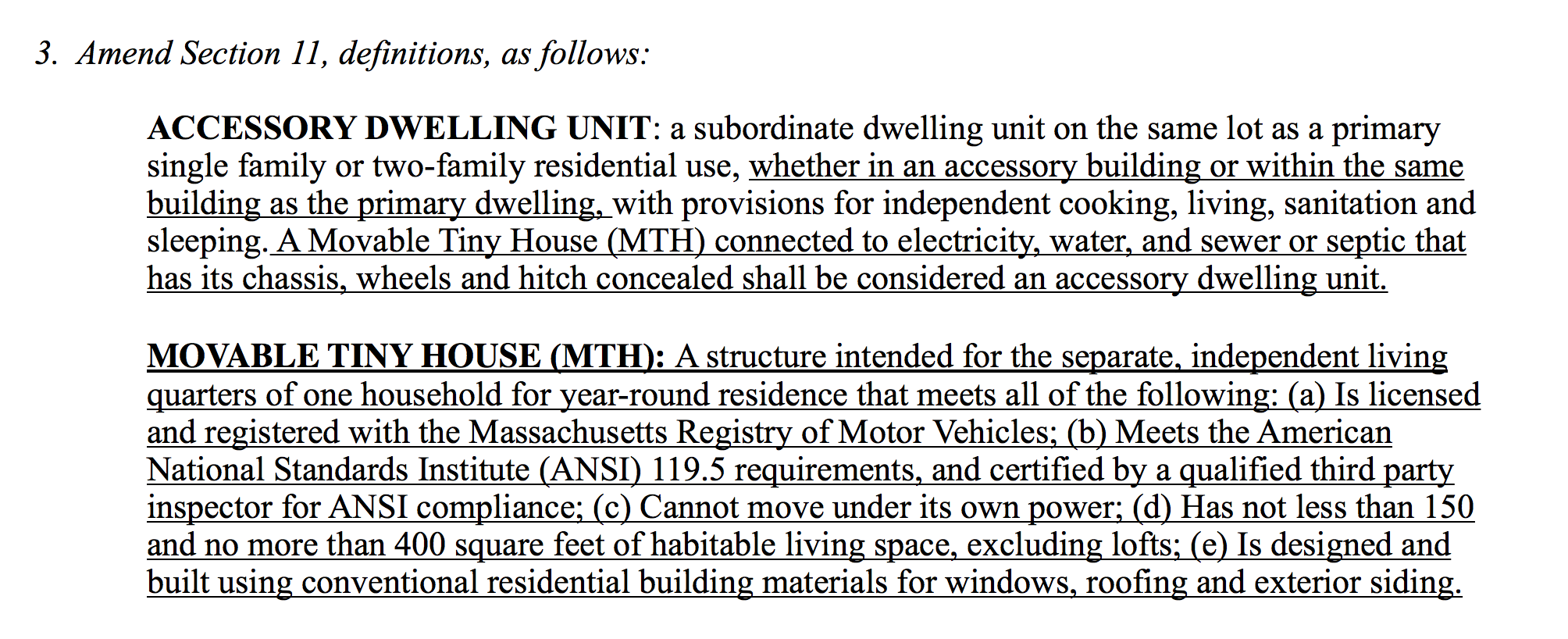
Acronym Key:
MTH: Movable Tiny House
THOW: Tiny House on Wheels
ADU: Accessory Dwelling Unit
-Tiny House Open House in the backyard of 65 Anderson Street, Great Barrington, MA 01230. Sunday, May 5, 10am-4pm.
Sunday’s tiny house open house is in advance of Monday’s Great Barrington Annual Meeting, where a proposed zoning amendment allowing Movable Tiny Houses as accessory dwelling units will be voted upon, among other topics. The open house is hosted by Amy Turnbull who is on the leadership team of the American Tiny House Association, with a movable tiny house built by Tony Indino of East Granby, Connecticut (this house is shown in the event flyer). This open house will give a glimpse into what backyard tiny houses might look like in Great Barrington if the Movable Tiny House Amendment passes.
-Great Barrington Annual Meeting & Vote at Monument Mountain High School Auditorium, 600 Stockbridge Rd, Great Barrington, MA 01230. Monday, May 6, 6:00pm.
Please attend the Annual Meeting on Monday in support of allowing movable tiny houses in Great Barrington backyards. The proposed amendment language is posted in the comments. All those who are registered to vote in Great Barrington may vote on the amendments.
Williamstown, MA had its planning board meeting last night, discussing whether to allow backyard cottages and second apartments to homes in certain zones of town. It was a full house, with others who couldn’t get seats standing in the hallway.
In the photo, Amy Jeschawitz, Chair of the Planning Board, sits under the town flag, depicting Williamstown’s beloved 1753 House. The 1753 House was originally called a “Regulation House” by the early European settlers, who, in order to be considered land owners, had to build a house that was at least 15’ x 18’ and 7’ tall. At 270 sq ft, this would certainly be considered a “tiny house” by today’s standards!
The size of the detached ADUs (backyard cottages) in the current proposed bylaw would be limited to between 900 and 1200 square feet, determined by the size of the existing home and its lot.
Also addressed was allowing a second unit to an existing single family home, either within or added on to the existing building. These two bylaws would mean that a single unit property within certain zones could ostensibly turn into a three-unit property.
The planning board voted 3-1 in favor of recommending the proposed bylaws, with the additional restriction of a five year wait between adding a second unit to a property and adding a third.
The bylaws will now be taken to Town Meeting.
Read more on the meeting from iBerkshires: https://www.iberkshires.com/story/59488/Williamstown-Planners-Recommend-Dwelling-Bylaw-Amendments.html
Last week’s public hearing in Great Barrington, MA addressed using tiny houses on wheels as backyard cottages. (If you haven’t already seen it or need a refresher, refer back to this blog post).
After the meeting, I spoke with Jonathan Hankin who is the president of the Planning Board. Here’s his recap:
As a side note, the Massachusetts Attorney General, Maura Healey, visited the B&B Tiny Houses workshop last year and said, in front of many members of the press, that she feels tiny houses are a good affordable housing option. She has also signed the Nantucket, MA zoning bylaw allowing tiny houses, so we feel good about Atty. Gen. Healey signing Great Barrington’s as well.
-K. Jackson
Pictured from left: B&B Tiny Houses Owners Chris St. Cyr, Jason Koperniak, Mitch Bressett, and Massachusetts Attorney General Maura Healey outside the Arcadia Tiny House. Photo from iBerkshires.com.
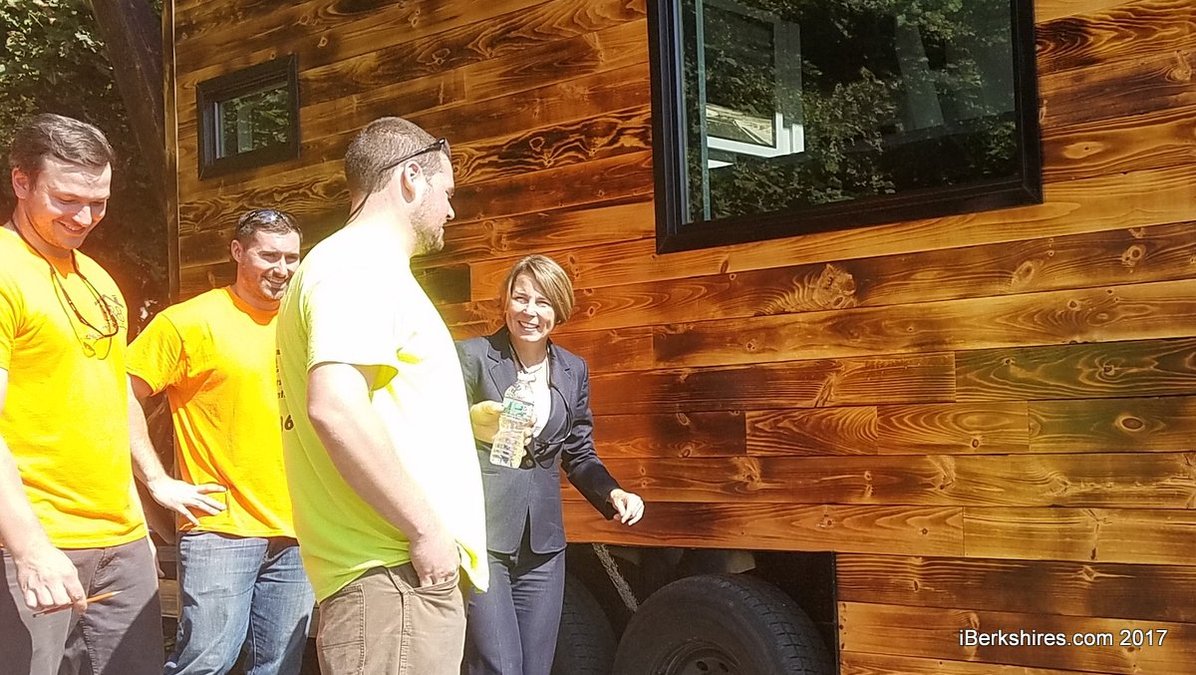
The Thursday meeting agenda includes a Citizen’s Speak Time, where those who live in Great Barrington can share their thoughts. Those who don’t live in Great Barrington but would like to show up in support of legal tiny houses may also attend the meeting.
This meeting will address movable tiny houses. Tiny houses that are on a foundation are already permitted as an ADU under the current bylaw and would need to meet the stretch code adopted by GB. The planning board is also seeking to increase the allowable number of ADUs to two.
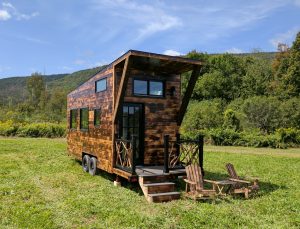
To Section 11.0 Definitions add:
Movable Tiny Houses (MTH)
A structure intended for the separate, independent living quarters of one household for year-round residence that meets all of the following:
(a) Is licensed and registered with the Massachusetts Registry of Motor Vehicles;
(b) Meets the American National Standards Institute (ANSI) 119.5 requirements, and certified by a qualified third party inspector for ANSI compliance;
(c) Cannot move under its own power;
(d) Has not less than 150 and no more than 430 square feet of habitable living space, excluding lofts;
(e) Is designed and built using conventional residential building materials for windows, roofing and exterior siding.
ACCESSORY DWELLING UNIT: a subordinate dwelling unit on the same lot as a primary single family or two-family residential use, with provisions for independent cooking, living, sanitation and sleeping. (Add) A Movable Tiny House (MTH) connected to electricity, water, and sewer or septic that has its chassis, wheels and hitch concealed shall be considered an accessory dwelling unit.
(This proposed language may have been updated by the time the meeting takes place).
Please attend:
Read the Meeting Agenda here.
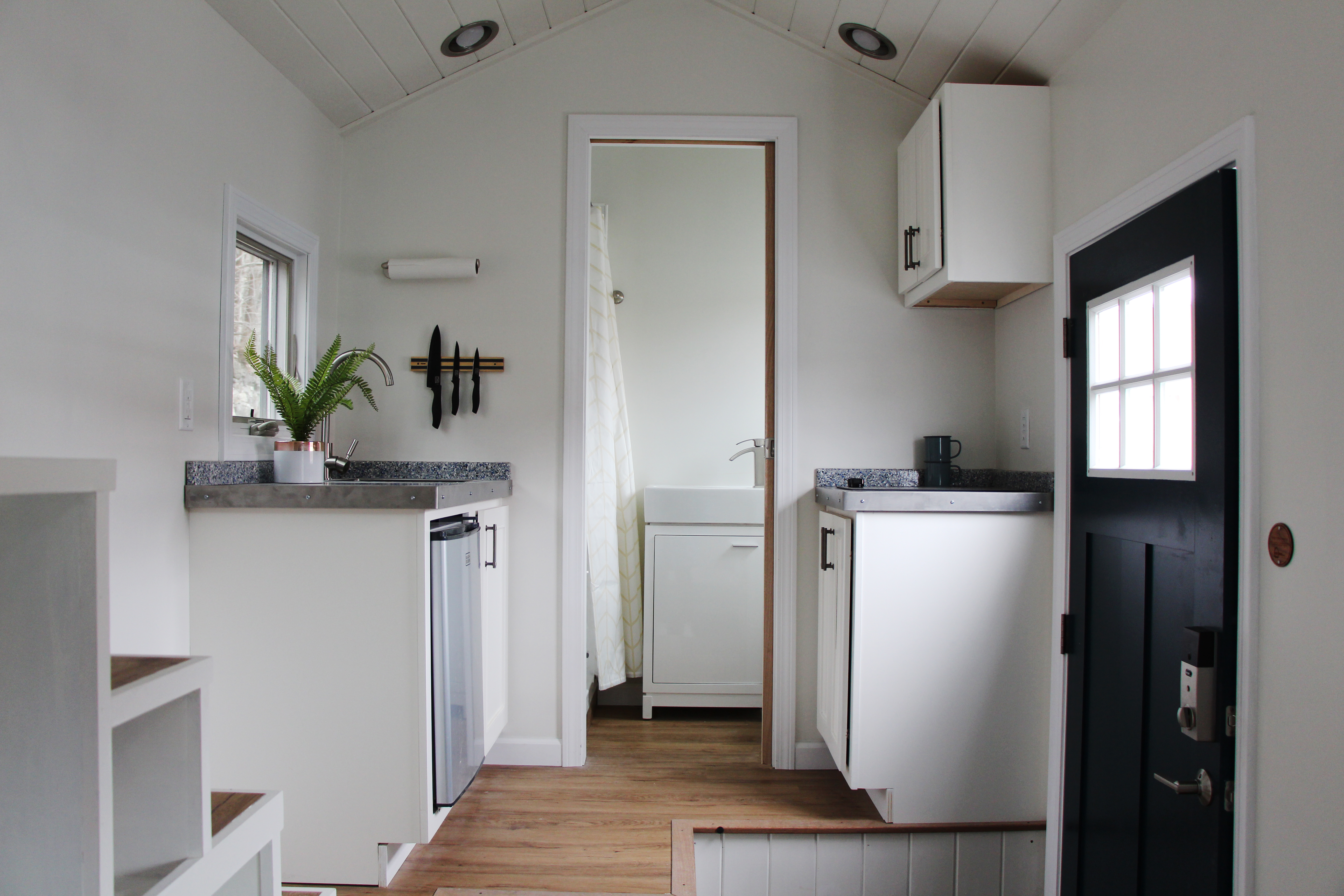
Much of saving money on a tiny house build involves understanding the many different options available to you in the tiny house buying process. Here are some points to consider when saving money in your tiny house.
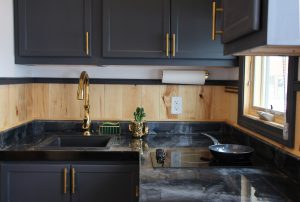
This is the single greatest money-saving action we can suggest. Custom designs will cost more than a house that’s already in our Signature Designs, and this applies to every step of the process, not just the design phase. Even after the designer’s finished with the blueprints, the builders will need to spend more time on each aspect of the house, since it’s not one they’ve built before. Time is a very large percentage of the final cost, and cutting down on our time spent working through new challenges with a custom tiny house will cut down your overall final cost.
But don’t worry, you can still make your tiny house your own, even if it’s picked out of our catalogue of Signature Models. You’ll be able to choose all the colors, materials, and fixtures for your tiny house.
We offer three options for making your tiny house your own:
CUSTOMIZATION CHOICES, like exterior and interior wall materials, appliances, colors, open shelving versus cabinetry with doors, are always free— these choices will be reflected in the materials and installation cost. These choices don’t require the tiny house designer to change anything about the blueprints of the house.
ALTERATIONS TO OUR EXISTING BLUEPRINTS are $800, which includes two free revisions. Any further revisions are billed at $50 per hour of the designer’s time. The extra build time and materials for an altered floor plan will be built into the quote. Alterations include adding a loft to houses where possible, changing window sizes and locations, designing a custom staircase, and changing the roof shape where possible.
ENTIRELY ORIGINAL DESIGNS are available when we will be building three or more tiny houses; there is a design fee of $2500. This includes two free revisions. Any further revisions are billed at $50 per hour of the designer’s time. The extra time taken to build a custom, rather than a mass-produced, tiny house will be built into the quote. Custom tiny houses generally start at $90,000.
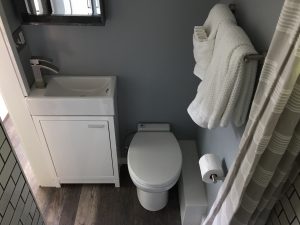
We can build anything you want as long as it’s within the RVIA’s safety standards. One of the owners of B&B Tiny Houses, Mitch, likes to say “we’ll build a slide off the roof” (we haven’t received an order for that one yet)! However, just because we can build something doesn’t mean it’s not going to cost money. Similarly to the previous section on choosing a standard design, choosing standard materials that we already know how to install and that they work well in tiny houses will save us time and save you money.
Our list of common upgrades for our tiny houses doesn’t represent everything we can do and everything we’ve ever built into a tiny house, but it’s a great representation of what upgrades we are comfortable making and already know how to install efficiently. We are happy to research, price, design for, and build with materials or fixtures that aren’t on that list: we’ll just have to build the extra time spent on non-standard materials into the final price. Don’t worry: we think you’ll be very happy finding exactly what you want within that extensive list. Sometimes we even have leftover materials from a previous project that might work well in your house that we can offer you a discount on: we’ll be sure to let you know if so.
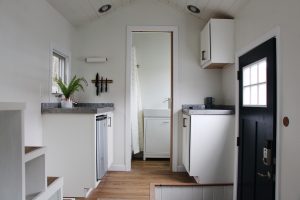
Another way to save money on your tiny house is to go with basic materials. Each tiny house is listed with a starting price. This starting price includes basic materials and fixtures. Here’s a list of our basic materials and what an upgraded material in the same category might be. The difference between tiny houses using all basic materials and tiny houses using all upgraded materials can be quite significant in the final total.
The kitchen shown in this Hoosic tiny house uses all basic materials included in the starting price: a two-burner built-in cooktop, a small kitchen sink, a mini-fridge built into the cabinetry. Of course, you can upgrade this kitchen to include an apartment-size fridge or built in fridge and freezer drawers, a propane stove and oven, a large undermount sink, and a convection oven/microwave (see these features in the Kinderhook tiny house), but this will, of course, cost much more. Being frugal with your appliance choices makes for a great deal of savings in the end.
| Starting Price Includes: | Upgraded Tiny House Might Include: | |
| Exterior | Vinyl Clapboard | Vertical Solid Wood Shiplap |
| Roofing | Asphalt Shingle | Ribbed Metal |
| Interior Walls | Sheetrock | Solid Wood Shiplap |
| Climate Control | In-Wall Electric Heater | Mini Split (Electric Heating & Cooling) |
| Cooking | 2-Burner Glass Cooktop | Stainless Steel 3-Burner Propane Stove/Oven with Range Hood |
| Refrigerator | Mini-Fridge | Apartment Size Fridge (24″ w x 68″ h x 25′ d, 10.1 cu. ft. |
| Dishwashing | Kitchen Sink | Kitchen Sink & Dishwasher (Certain Models Only) |
| Shower/Tub Insert | Vinyl | Custom Tile |
| Bathroom Sink | Mini Sink with Vanity | Mini or Full-Size Sink with Vanity |
| Washer/Dryer | Not Included |
Washer/Dryer Combo (Certain Models Only– Not Available with Solar Power)
|
| Toilet | Your Choice- Inquire For Pricing | Your Choice- Inquire For Pricing |
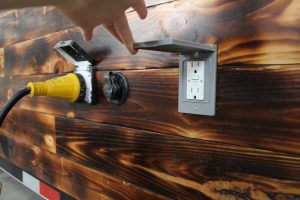
Going off-grid in a tiny house is possible, but the up-front cost isn’t cheap. Likewise, if you’ll want to run electric appliances in your off-grid tiny house, you can, but not as many or as often as you might when you’re on grid. The cost of setting up a solar system capable of running appliances in the same way that one normally might in an on-grid situation can double the cost of the tiny house itself! Running large appliances like a washer/dryer, or many appliances at once, will require large battery storage as well as an array of many solar panels: more that can fit onto the roof of a tiny house.
If you will go with off-grid solar and want to be frugal (or if you’d like to travel with your solar panels), you’ll have to eliminate most electric-run appliances from your list and plan on using other sources of energy, like propane.
The simplest, cheapest power source for your tiny house is running an extension cord and a potable water hose (with heat tape in winter!) from a building that already has power and water. Many people who live in their tiny houses full-time park their houses beside or behind the house of a friend, relative or landlord. Others may lease or purchase a property that already has a power source. The cost of these hookups is included in the starting price of all our tiny houses.
Check out this blog post for more info on how to hook up your tiny house to water and power.
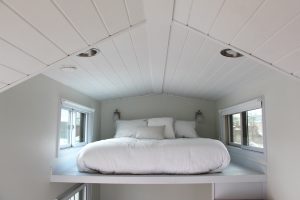
Choose your favorite of our Signature Tiny House Models and then get an Instant Estimate for that house with the features and fixtures you want.
When you’re comfortable with your price, contact us to get started.
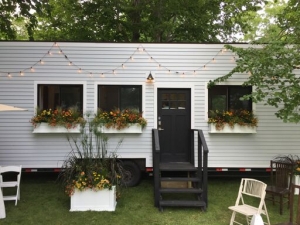 For some this is easy: a backyard, a piece of property in a town that allows RVs, or an RV park. For those who don’t yet know where to put their tiny house, finding a location to put their tiny house is a crucial step. We’ll build your tiny house differently depending on whether you plan to travel often with your house or it’ll stay in one place. There are many different customization options available for your tiny house, which often depend on what kind of utilities are available at your tiny house site.
For some this is easy: a backyard, a piece of property in a town that allows RVs, or an RV park. For those who don’t yet know where to put their tiny house, finding a location to put their tiny house is a crucial step. We’ll build your tiny house differently depending on whether you plan to travel often with your house or it’ll stay in one place. There are many different customization options available for your tiny house, which often depend on what kind of utilities are available at your tiny house site.
You’ll need to make sure your site has an access road and enough room for a truck to deliver the tiny house. If you send us the layout of your property we’ll help you determine the best spot to place your tiny house during your design session.
Here’s a blog post on where to put your tiny house, and what to know if you’re thinking of buying land for your tiny house.
One way to find a location is through networking. Here’s a list of tiny house networking sites: most of these groups are through Facebook or Meetup.
If you’re finding it difficult to find a town that already allows tiny houses, you’re not alone. In fact, most towns’ Planning/Zoning Boards haven’t even considered whether to allow tiny houses on wheels: all it’ll take to start the wheels turning (pun intended, sorry) is for someone to ask. The American Tiny House Association (Website, Facebook) is a great resource for those who would like to ask for permission to live in their tiny houses.
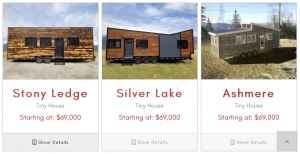 Know where you’ll put your tiny house? Great! Browse our tiny house catalogue online and decide which model is the best for you. Each of our models is customizable: customizations like materials and paint colors are free, while having our designer change the blueprints is an extra fee.
Know where you’ll put your tiny house? Great! Browse our tiny house catalogue online and decide which model is the best for you. Each of our models is customizable: customizations like materials and paint colors are free, while having our designer change the blueprints is an extra fee.
Some of our tiny houses are the road-legal limit of 8 1/2′ wide. If you’re looking for a tiny house you can tow with you, check out our Lightweight Models for Towing. We also offer Park Model Tiny Houses at 10′ wide, the Taconic and the Kinderhook. Park Models are great when you want a little extra elbow room and don’t plan to move your tiny house after it’s put in place.
Don’t want to climb up a ladder to go to bed? Click here to see our models with a first-floor bed.
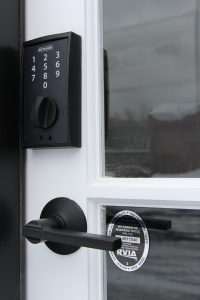 B&B’s Tiny Houses on wheels are inspected by the Recreation Vehicle Industry Association, or the RVIA. Your tiny house will come with an individual seal showing it’s been certified. Because they’re certified to RVIA standards, our tiny houses are legally considered RVs, and can get RV financing, insurance, and access to RV parks. Having this certification also helps when explaining to your town’s Planning and Zoning Board exactly what a tiny house is and how it’s certified.
B&B’s Tiny Houses on wheels are inspected by the Recreation Vehicle Industry Association, or the RVIA. Your tiny house will come with an individual seal showing it’s been certified. Because they’re certified to RVIA standards, our tiny houses are legally considered RVs, and can get RV financing, insurance, and access to RV parks. Having this certification also helps when explaining to your town’s Planning and Zoning Board exactly what a tiny house is and how it’s certified.
If you’ll use financing, down payments differ based on the financial institution, but they’re generally between 20 and 25%. If you’ll pay cash, we generally charge 60% up front and 40% when the house is complete. You’ll need to have this amount saved before you buy a tiny house.
To find out about how much the tiny house you want would cost, try our Instant Estimate Generator. This will give you a ballpark estimate so you’ll know how much to save. If you’re not comfortable with your first estimate, you can go back through the Estimator as many times as you’d like, choosing different options. Here are some suggested financial institutions for getting RV financing for your tiny house.
Keep in mind that the cost of the tiny house itself isn’t the only expense you may have when placing a tiny house. Depending on your site and what your municipality requires, you may need to have utilities connected, a gravel or concrete pad poured, and anchors installed. If you’re not towing your tiny house yourself, you’ll need to pay about $2 per mile for delivery (we’ll connect you with our trusted delivery company). It’s important to factor in the all-in cost of buying a tiny house before paying a deposit.
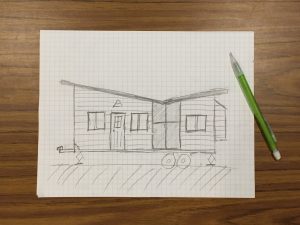 Whether you’d like to make changes to the blueprints of the tiny house or not, a design session is the next step. If the only design changes are your selections for colors, materials and fixtures, these choices are free to make; the cost of the materials you choose will be reflected in your final quote. If you’ll make changes to the blueprints, we charge a Design Alteration fee before our design session (scroll down past the customization options to see the fee).
Whether you’d like to make changes to the blueprints of the tiny house or not, a design session is the next step. If the only design changes are your selections for colors, materials and fixtures, these choices are free to make; the cost of the materials you choose will be reflected in your final quote. If you’ll make changes to the blueprints, we charge a Design Alteration fee before our design session (scroll down past the customization options to see the fee).
Contact us to set up a time for a design session, whether via Skype, phone, or in-person. If your session is in person, we’ll walk you through any tiny house that we may have at our shop so you can get a feel for the space. During our design session, we’ll go through, in detail, which options you’d like, and the pros and cons of each depending on your location and how you’ll be using your tiny house. You’ll have a chance to get your tiny house questions answered as well as learn more about which options are realistic for your living situation.
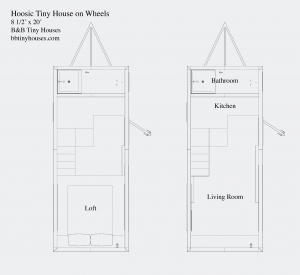 After your design session, our team will create a quote for your tiny house. If you need changes to the existing plans, we’ll create a new drawing: this can take a few weeks depending on our design pipeline.
After your design session, our team will create a quote for your tiny house. If you need changes to the existing plans, we’ll create a new drawing: this can take a few weeks depending on our design pipeline.
We’ll review your quote and final customization plan (your choices for colors, materials, fixtures, etc.) with you.
When you’re ready to finalize your choices and move forward, we’ll send you a build contract.
When we receive your signed contract and first payment (if you’re paying with cash, 60%; if you’re financing, we’ll need the payment from your financial institution) we’ll start ordering materials for your tiny house.
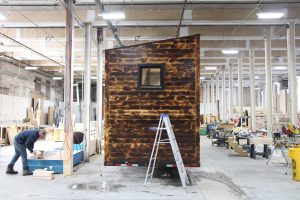 Our build schedule varies throughout the year: sometimes we can start building a tiny house right away, and other times there will be other projects in the pipeline. We’ll be sure to keep you updated on our build schedule.
Our build schedule varies throughout the year: sometimes we can start building a tiny house right away, and other times there will be other projects in the pipeline. We’ll be sure to keep you updated on our build schedule.
Trailers take about five weeks to build; your tiny house, depending on its size and level of complexity, should take 6-12 weeks after that depending on our build schedule. We’ll keep in touch with you during the build process.
 The needs of tiny house sites vary greatly. If you’ll be traveling with your tiny house and parking it at RV Parks, there’s not much you’ll need to do other than reserve your spot. If you’ll be keeping your tiny house in one place, you’ll need to make sure you can get water and power to your tiny house and waste water away from it. Depending on the permanency of your tiny house, you may want to have a gravel or concrete pad poured, and lay water and electric lines. If you’re going solar, you’ll need to contract with a solar company to have your panels installed on your site.
The needs of tiny house sites vary greatly. If you’ll be traveling with your tiny house and parking it at RV Parks, there’s not much you’ll need to do other than reserve your spot. If you’ll be keeping your tiny house in one place, you’ll need to make sure you can get water and power to your tiny house and waste water away from it. Depending on the permanency of your tiny house, you may want to have a gravel or concrete pad poured, and lay water and electric lines. If you’re going solar, you’ll need to contract with a solar company to have your panels installed on your site.
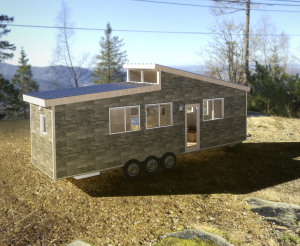 If you’ll be towing your tiny house, here’s a primer on what size vehicle you’ll need.
If you’ll be towing your tiny house, here’s a primer on what size vehicle you’ll need.
Those who do not plan to tow their own tiny house may have it professionally delivered to their site. Contact us for a delivery estimate. We’ll schedule a time with you to ensure you’re on-site when your house is delivered, and we’ll answer any questions you might have about setting it in place.
Ready to choose a tiny house model? Check out our Tiny House Designs and then get an Instant Estimate.
Have Questions? Contact us.
Learn more about our process or fill out the form below and one of our tiny house experts will reach out to you.
